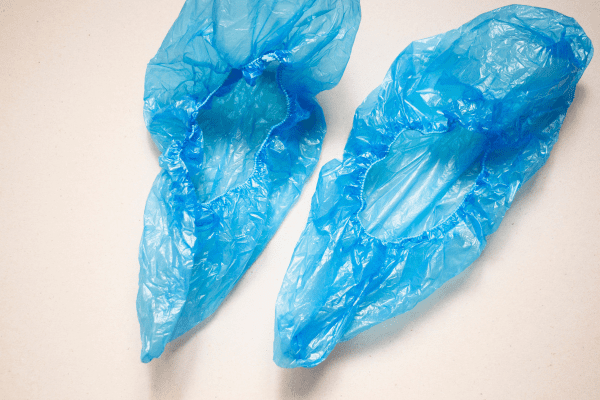Dycem® vs Shoe Covers
Due to 80% of contamination entering at floor level, numerous industries often use shoe covers as a preventative measure to safeguard cleanrooms or controlled environments from the footwear of personnel entering the area. Shoe covers refer to slip-on garments that fit over various footwear styles and sizes, keeping the shoe’s sole from coming into contact with the floor. They are readily available in a variety of options from numerous distributors. Although covering up your shoes may seem like a no-brainer, several risks should not be ignored.
Waste
Most shoe covers are made of disposable plastic and are designed for single use. Operators must apply new or dispose of used covers each time they enter or exit a controlled environment, which could be multiple times a day. Additionally, varying control classifications within a facility may require multiple layers of shoe covers. Waste is also created by operator error in grabbing more than one pair at a time or inadvertently contaminating a cover by dropping it on the floor and rendering it unusable.
Through years of customer satisfaction and scientifically backed data, Dycem mats are proven to be a superior long-term solution. Because the mats are washable and reusable over an average lifespan of 3+ years, dependence on single-use plastics is reduced. All Dycem mats are responsibly manufactured in accordance with sustainability standards.


Cross-Contamination
The physical act of using your hands to place a cover over your shoe can lead to several issues. If the hand applying the cover is unwashed, the cover can become contaminated. Additionally, if the hand touches the bottom of the exposed shoe while applying the cover, there is a risk of contamination transfer. Because of varying materials and quality levels, some shoe covers are prone to shedding particulate and even ripping, allowing a dirty shoe to come in contact with the floor.
Dycem mats attract and capture all particulate that comes in contact with or near its surface. The polymer’s high surface energy and natural tack retain particulate and prevent any redistribution into the environment. The Biomaster silver additive restricts any additional growth of potentially harmful microbes.
Know the facts...
Currently using an alternative to Dycem?
Make sure you understand the risks of common contamination control solutions. Download our comparison brochure to learn more!
Employee Downtime
Applying shoe covers can create a bottleneck in employee gowning procedures. Because a covered shoe is now considered “clean”, it must not come in contact with a “dirty” area. Therefore, extreme caution and extra time must be taken in the process.
Placed in the unavoidable traffic flow, operators must walk over the Dycem mats as part of their regular entry or exit procedures. Downtime from additional training or extra processes is prevented. Maintenance is minimal for the lifespan of the mats, which is 3+ years on average. There is no continual ordering and stocking of supplies required. Once installed, Dycem mats are easily incorporated into the daily wet cleaning schedule and ready for re-use.


Health & Safety
Shoe covers can pose several health and safety risks to employees. If the fit is inaccurate or covers are not appropriately applied, potential tripping or slipping may occur. Often used with peel-off tacky mats, shoe covers can be ripped or pulled off easily by the strong adhesive, causing a safety concern.
Dycem mats are a solution that promotes safe operations within the facility. Because they are low profile and sealed to the subfloor, Dycem mats allow employees to easily walk across and remove the risk of tripping or falling. The Biomaster antimicrobial additive is stable, non-leaching, and effective for the entire life of the product (3+ years).
Total Costs
The low-cost price tag initially associated with shoe covers can add up quickly, especially for larger facilities with higher volumes of people and multiple layers of control requirements. The hidden costs of employee downtime for use, potential health and safety claims, and the risk of recalls or rejected batches from contamination cannot be ignored.
With a lifespan of 3+ years, minimal downtime for use, less waste, and, most importantly, the reduction of high-priced contamination issues, Dycem mats provide a superior return on investment and are the most efficient total-cost solution.

